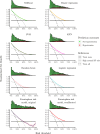Development of risk models of incident hypertension using machine learning on the HUNT study data
- PMID: 38454041
- PMCID: PMC10920790
- DOI: 10.1038/s41598-024-56170-7
Development of risk models of incident hypertension using machine learning on the HUNT study data
Abstract
In this study, we aimed to create an 11-year hypertension risk prediction model using data from the Trøndelag Health (HUNT) Study in Norway, involving 17 852 individuals (20-85 years; 38% male; 24% incidence rate) with blood pressure (BP) below the hypertension threshold at baseline (1995-1997). We assessed 18 clinical, behavioral, and socioeconomic features, employing machine learning models such as eXtreme Gradient Boosting (XGBoost), Elastic regression, K-Nearest Neighbor, Support Vector Machines (SVM) and Random Forest. For comparison, we used logistic regression and a decision rule as reference models and validated six external models, with focus on the Framingham risk model. The top-performing models consistently included XGBoost, Elastic regression and SVM. These models efficiently identified hypertension risk, even among individuals with optimal baseline BP (< 120/80 mmHg), although improvement over reference models was modest. The recalibrated Framingham risk model outperformed the reference models, approaching the best-performing ML models. Important features included age, systolic and diastolic BP, body mass index, height, and family history of hypertension. In conclusion, our study demonstrated that linear effects sufficed for a well-performing model. The best models efficiently predicted hypertension risk, even among those with optimal or normal baseline BP, using few features. The recalibrated Framingham risk model proved effective in our cohort.
© 2024. The Author(s).
Conflict of interest statement
The authors declare no competing interests.
Figures






Similar articles
-
Machine learning-based models to predict the conversion of normal blood pressure to hypertension within 5-year follow-up.PLoS One. 2024 Mar 14;19(3):e0300201. doi: 10.1371/journal.pone.0300201. eCollection 2024. PLoS One. 2024. PMID: 38483860 Free PMC article.
-
Prediction and feature selection of low birth weight using machine learning algorithms.J Health Popul Nutr. 2024 Oct 12;43(1):157. doi: 10.1186/s41043-024-00647-8. J Health Popul Nutr. 2024. PMID: 39396025 Free PMC article.
-
Machine learning algorithms identify hypokalaemia risk in people with hypertension in the United States National Health and Nutrition Examination Survey 1999-2018.Ann Med. 2023 Dec;55(1):2209336. doi: 10.1080/07853890.2023.2209336. Ann Med. 2023. PMID: 37162442 Free PMC article.
-
Interpretable machine learning for allergic rhinitis prediction among preschool children in Urumqi, China.Sci Rep. 2024 Sep 27;14(1):22281. doi: 10.1038/s41598-024-73733-w. Sci Rep. 2024. PMID: 39333659 Free PMC article.
-
A Risk Prediction Model for Physical Restraints Among Older Chinese Adults in Long-term Care Facilities: Machine Learning Study.J Med Internet Res. 2023 Apr 6;25:e43815. doi: 10.2196/43815. J Med Internet Res. 2023. PMID: 37023416 Free PMC article.
Cited by
-
Evaluation of Machine Learning and Traditional Statistical Models to Assess the Value of Stroke Genetic Liability for Prediction of Risk of Stroke Within the UK Biobank.Healthcare (Basel). 2025 Apr 26;13(9):1003. doi: 10.3390/healthcare13091003. Healthcare (Basel). 2025. PMID: 40361781 Free PMC article.
References
MeSH terms
LinkOut - more resources
Full Text Sources
Medical

